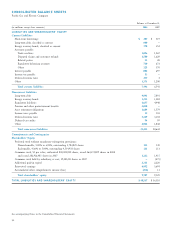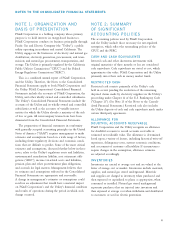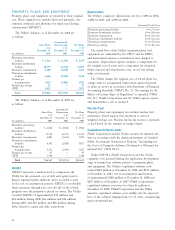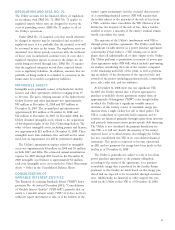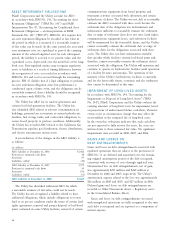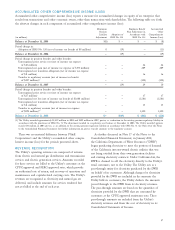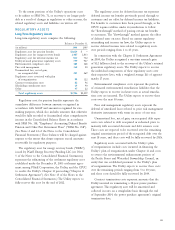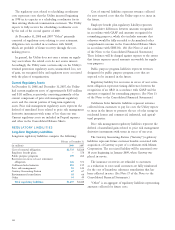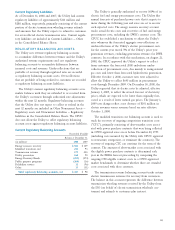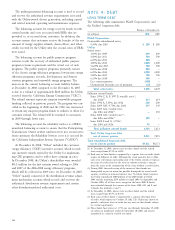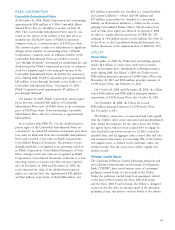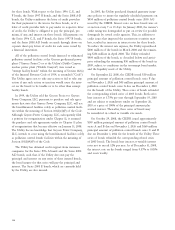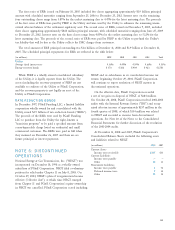PG&E 2008 Annual Report Download - page 102
Download and view the complete annual report
Please find page 102 of the 2008 PG&E annual report below. You can navigate through the pages in the report by either clicking on the pages listed below, or by using the keyword search tool below to find specific information within the annual report.100
to incorporate any third-party credit enhancements that
are issued with and are inseparable from a debt instrument
into the fair value of that debt instrument. EITF 08-5 is
effective prospectively for fi scal years beginning on or
after December 15, 2008, and interim periods within those
fi scal years. PG&E Corporation and the Utility are currently
evaluating the impact of EITF 08-5.
Equity Method Investment Accounting Considerations —
an amendment to Accounting Principles Board No. 18
In November 2008, the FASB issued Emerging Issues Task
Force 08-6, “Equity Method Accounting Considerations”
(“EITF 08-6”). EITF 08-6 clarifi es the application of equity
method accounting under Accounting Principles Board 18,
“The Equity Method of Accounting for Investments in
Common Stock.” Specifi cally, it requires companies to
initially record equity method investments based on the cost
accumulation model, precludes separate other-than-temporary
impairment tests on an equity method investee’s indefi nite-
lived assets from the investee’s test, requires companies to
account for an investee’s issuance of shares as if the equity
method investor had sold a proportionate share of its invest-
ment, and requires that an equity method investor continue
to apply the guidance in paragraph 19(l) of Opinion 18
upon a change in the investor’s accounting from the equity
method to the cost method. EITF 08-6 is effective prospec-
tively for fi scal years beginning on or after December 15,
2008, and interim periods within those fi scal years. PG&E
Corporation and the Utility are currently evaluating the
impact of EITF 08-6.
NOTE 3: REGULATORY
ASSETS, LIABILITIES, AND
BALANCING ACCOUNTS
The Utility accounts for the fi nancial effects of regulation
in accordance with SFAS No. 71. SFAS No. 71 applies
to regulated entities whose rates are designed to recover
the cost of providing service. SFAS No. 71 applies to all
of the Utility’s operations.
Under SFAS No. 71, incurred costs that would otherwise
be charged to expense may be capitalized and recorded as
regulatory assets if it is probable that the incurred costs will
be recovered in future rates. The regulatory assets are amor-
tized over future periods consistent with the inclusion of
costs in authorized customer rates. If costs that a regulated
enterprise expects to incur in the future are currently being
recovered through rates, SFAS No. 71 requires that the
regulated enterprise record those expected future costs as
regulatory liabilities. In addition, amounts that are probable
of being credited or refunded to customers in the future
must be recorded as regulatory liabilities.
ACCOUNTING PRONOUNCEMENTS
ISSUED BUT NOT YET ADOPTED
Disclosures about Derivative Instruments and Hedging
Activities — an amendment of FASB Statement No. 133
In March 2008, the FASB issued SFAS No. 161, “Disclosures
about Derivative Instruments and Hedging Activities — an
amendment of FASB Statement No. 133” (“SFAS No. 161”).
SFAS No. 161 amends and expands the disclosure require-
ments of SFAS No. 133. An entity is required to provide
qualitative disclosures about objectives and strategies for
using derivatives, quantitative disclosures on fair value
amounts of, and gains and losses on, derivative instruments,
and disclosures relating to credit-risk-related contingent
features in derivative agreements. SFAS No. 161 is effective
prospectively for fi scal years beginning after November 15,
2008. PG&E Corporation and the Utility will include the
expanded disclosure required by SFAS No. 161 in their
combined quarterly report on Form 10-Q for the quarter
ended March 31, 2009.
Disclosures about Employers’ Postretirement
Benefi t Plan Assets — an amendment
to FASB Statement No. 132(R)
In December 2008, the FASB issued FSP FAS 132(R)-1,
“Employers’ Disclosures about Postretirement Benefi t Plan
Assets” (“FSP 132(R)-1”). FSP 132(R)-1 amends and expands
the disclosure requirements of SFAS No. 132. An entity is
required to provide qualitative disclosures about how invest-
ment allocation decisions are made, the inputs and valuation
techniques used to measure the fair value of plan assets, and
the concentration of risk within plan assets. Additionally,
quantitative disclosures are required showing the fair value
of each major category of plan assets, the levels in which
each asset is classifi ed within the fair value hierarchy, and a
reconciliation for the period of plan assets that are measured
using signifi cant unobservable inputs. FSP 132(R)-1 is effec-
tive prospectively for fi scal years ending after December 15,
2009. PG&E Corporation and the Utility are currently
evaluating the impact of FSP 132(R)-1.
Issuer’s Accounting for Liabilities Measured
at Fair Value with a Third-Party Credit
Enhancement — an amendment to FASB
Statement No. 107 and FASB Statement No. 133
In September 2008, the FASB issued Emerging Issues Task
Force (“EITF”) 08-5, “Issuer’s Accounting for Liabilities
Measured at Fair Value with a Third-Party Credit Enhance-
ment” (“EITF 08-5”). EITF 08-5 clarifi es the unit of account
in determining the fair value of a liability under SFAS
No. 107, “Disclosures about Fair Value of Financial
Instruments” or SFAS No. 133, “Accounting for Derivatives
and Hedging Activities.” Specifi cally, it requires an entity


